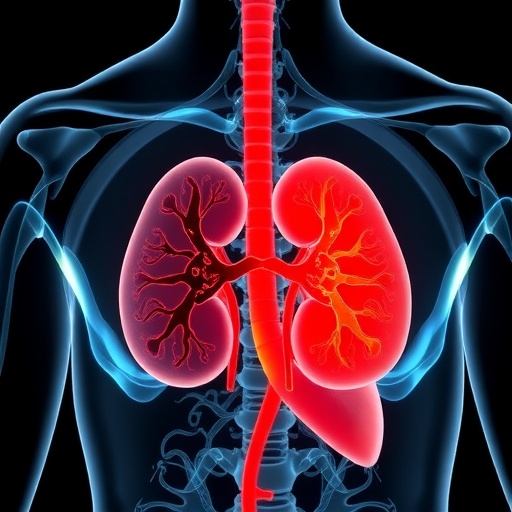PROTECT YOUR DNA WITH QUANTUM TECHNOLOGY
Orgo-Life the new way to the future Advertising by Adpathway
In the steadily escalating global health crisis of type 2 diabetes (T2D), the demand for groundbreaking approaches to predict and prevent this debilitating disease has never been more urgent. A recent prospective cohort study spearheaded by Fan, Yen, Lin, and colleagues provides compelling insights into novel biomarkers that could revolutionize how we assess T2D risk long before clinical symptoms manifest. Their comprehensive investigation centers on the intricate interplay among plasma sphingosine-1-phosphate (S1P), apolipoprotein M (ApoM), and obesity-related measures, unveiling potential avenues for earlier, more precise risk stratification.
For decades, the epidemiological trends of T2D have been alarmingly upward, closely linked to the burgeoning obesity pandemic. Despite advances in understanding the metabolic disturbances leading to insulin resistance and beta-cell dysfunction, current predictive models largely rely on traditional markers such as fasting glucose and HbA1c levels. These metrics, however, often detect disease only after significant metabolic derangement has occurred. The promise embedded within plasma S1P and ApoM lies in their capacity to reflect underlying pathophysiological changes associated with diabetes development in a subtler, more dynamic fashion.
Sphingosine-1-phosphate is a bioactive sphingolipid metabolite involved in various cellular processes including inflammation, angiogenesis, and lipid metabolism. Its role in metabolic disorders has garnered increasing attention, as dysregulated S1P signaling pathways are implicated in insulin resistance and chronic low-grade inflammation—two central drivers of T2D pathogenesis. ApoM, primarily known as a carrier protein for S1P, modulates its bioavailability and receptor interactions, thereby influencing systemic metabolic homeostasis. This biochemical partnership makes the duo an attractive focal point for investigating metabolic disease trajectories.
The study methodically tracked a large cohort of initially non-diabetic individuals over multiple years, meticulously quantifying baseline plasma levels of S1P and ApoM alongside detailed anthropometric data reflective of obesity status, such as body mass index (BMI) and waist circumference. Through rigorous statistical modeling accounting for confounding factors like age, sex, and lifestyle, the researchers endeavored to illuminate predictive associations and causal pathways linking these biomarkers to incident T2D.
One of the groundbreaking revelations from this research was the observation that higher plasma S1P concentrations were inversely correlated with the future development of T2D, independent of conventional obesity indices. This counterintuitive finding challenges prevailing notions that elevated bioactive lipid signaling universally portends metabolic dysfunction, suggesting instead that S1P may exert protective effects under certain physiological contexts. Furthermore, ApoM levels demonstrated a similarly intricate relationship with diabetes risk, underscoring its regulatory impact on S1P activity.
The implications of these findings ripple far beyond academic curiosity—they suggest that targeting the S1P-ApoM axis could herald new preventive strategies or therapeutic interventions. Modulating this pathway to enhance favorable metabolic signaling might attenuate the trajectory toward overt diabetes, sparing millions from its associated complications including cardiovascular disease, neuropathy, and renal failure.
Moreover, the nuanced interdependencies unveiled between obesity measures and plasma biomarker profiles illuminate why some obese individuals develop T2D whereas others remain metabolically resilient. It appears that the qualitative nature of lipid signaling milieu, as epitomized by S1P and its chaperone ApoM, may differentiate between benign and deleterious obesity phenotypes. This opens doors to more individualized risk assessments, transcending the simplistic quantity-based obesity metrics long relied upon in clinical practice.
Underlying molecular mechanisms posited by the authors involve S1P-mediated activation of specific G protein-coupled receptors which influence glucose uptake, insulin sensitivity, and inflammatory cascades within adipose tissue and liver. ApoM’s role in chaperoning S1P optimizes receptor targeting and signaling fidelity, ensuring that cellular responses are appropriately calibrated according to metabolic demands. Disruptions to this finely balanced system may tip the scales toward insulin resistance and beta-cell dysfunction.
Technical analyses leveraged high-throughput lipidomic profiling paired with state-of-the-art immunoassays to ensure robust quantification of plasma S1P and ApoM concentrations. Coupled with longitudinal clinical data, this enabled a rare integration of molecular biochemistry with epidemiology, a frontier approach essential for unraveling complex metabolic diseases.
Importantly, the study refrains from oversimplification. The authors carefully acknowledge limitations such as residual confounding and population-specific effects, advocating for replication across diverse cohorts. Additionally, they underscore the need for mechanistic experiments to substantiate causal links and explore therapeutic manipulations in vivo.
In the context of broader metabolic research, these findings resonate with emerging paradigms that recognize sphingolipid metabolism as a pivotal mediator of systemic energy homeostasis and inflammatory tone. As the field advances, the S1P-ApoM duo may join the ranks of transformative biomarkers that inform precision medicine approaches in diabetes care, from risk evaluation to targeted therapeutics.
This research also intersects with ongoing explorations into how lifestyle interventions, including diet and exercise, modulate sphingolipid profiles. Future clinical translation may integrate plasma S1P and ApoM measurements into personalized wellness programs, tailoring prevention efforts to individual molecular signatures.
The urgency of innovative strategies has never been clearer. With projections estimating that over 700 million adults worldwide could be diabetic by 2045, harnessing the predictive power of lipid signaling molecules represents a promising frontier to curb this tide. This study lays foundational groundwork for reimagining how we conceptualize and combat T2D risk at a biochemical level, opening a beacon of hope amid a daunting public health challenge.
Ultimately, the exciting avenue unveiled by Fan and colleagues transcends traditional metabolic biomarkers. By capturing the dynamic interplays between lipid mediators and obesity-related phenotypes, their work contributes to a paradigm shift toward more sophisticated, mechanistically informed approaches to diabetes prevention and management.
As research continues to elucidate the multifaceted roles of sphingolipids in metabolic disease, it is conceivable that plasma S1P and ApoM profiling could become standard components of metabolic health assessments in the not-so-distant future. Their integration with genomic, proteomic, and clinical data could empower clinicians with unprecedented predictive accuracy, transforming the landscape of chronic disease management.
In sum, this seminal investigation not only advances scientific understanding of critical metabolic pathways but also heralds a transformative chapter in public health strategy. By shining a light on the nuanced roles of plasma sphingosine-1-phosphate and apolipoprotein M in T2D risk, it challenges the field to rethink biomarkers, risk stratification, and ultimately, the very nature of diabetes prevention itself.
Subject of Research: The investigation of plasma sphingosine-1-phosphate and apolipoprotein M as biomarkers linked to obesity and the risk of incident type 2 diabetes.
Article Title: The relationship between plasma sphingosine-1-phosphate, plasma apolipoprotein M, obesity, and the risk of incident type 2 diabetes: a prospective cohort study.
Article References:
Fan, KC., Yen, IW., Lin, CH. et al. The relationship between plasma sphingosine-1-phosphate, plasma apolipoprotein M, obesity, and the risk of incident type 2 diabetes: a prospective cohort study.
Int J Obes (2025). https://doi.org/10.1038/s41366-025-01890-7
Image Credits: AI Generated
DOI: https://doi.org/10.1038/s41366-025-01890-7
Tags: apolipoprotein M significancecohort study on diabetes riskearly detection of diabetesinflammation and lipid metabolisminsulin resistance and obesitymetabolic disturbances in obesityobesity and diabetes riskpathophysiology of type 2 diabetesplasma lipids and type 2 diabetespredictive models for T2Dpreventive strategies for diabetes managementsphingosine-1-phosphate biomarkers


 5 hours ago
7
5 hours ago
7





















 English (US) ·
English (US) ·  French (CA) ·
French (CA) ·